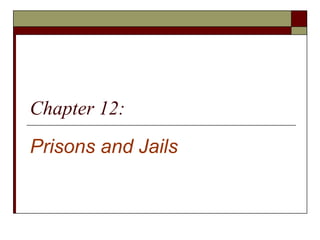Chapter12
•Télécharger en tant que PPT, PDF•
1 j'aime•532 vues
Cengage Learning Publications Chapter 12 Content for Psychology and/or Criminal Justice Course
Signaler
Partager
Signaler
Partager

Recommandé
Recommandé
Contenu connexe
Similaire à Chapter12
Similaire à Chapter12 (16)
DETENTION is the part of corrections that takes place before.docx

DETENTION is the part of corrections that takes place before.docx
1. Discuss the prison subculture for inmates and correction.docx

1. Discuss the prison subculture for inmates and correction.docx
jciprod01productnHHLL52-1HLL107.txt unknown Seq 1 17-M.docx

jciprod01productnHHLL52-1HLL107.txt unknown Seq 1 17-M.docx
Dernier
Dernier (20)
Sensory_Experience_and_Emotional_Resonance_in_Gabriel_Okaras_The_Piano_and_Th...

Sensory_Experience_and_Emotional_Resonance_in_Gabriel_Okaras_The_Piano_and_Th...
HMCS Vancouver Pre-Deployment Brief - May 2024 (Web Version).pptx

HMCS Vancouver Pre-Deployment Brief - May 2024 (Web Version).pptx
General Principles of Intellectual Property: Concepts of Intellectual Proper...

General Principles of Intellectual Property: Concepts of Intellectual Proper...
On National Teacher Day, meet the 2024-25 Kenan Fellows

On National Teacher Day, meet the 2024-25 Kenan Fellows
Python Notes for mca i year students osmania university.docx

Python Notes for mca i year students osmania university.docx
Kodo Millet PPT made by Ghanshyam bairwa college of Agriculture kumher bhara...

Kodo Millet PPT made by Ghanshyam bairwa college of Agriculture kumher bhara...
ICT role in 21st century education and it's challenges.

ICT role in 21st century education and it's challenges.
Jual Obat Aborsi Hongkong ( Asli No.1 ) 085657271886 Obat Penggugur Kandungan...

Jual Obat Aborsi Hongkong ( Asli No.1 ) 085657271886 Obat Penggugur Kandungan...
Micro-Scholarship, What it is, How can it help me.pdf

Micro-Scholarship, What it is, How can it help me.pdf
Basic Civil Engineering first year Notes- Chapter 4 Building.pptx

Basic Civil Engineering first year Notes- Chapter 4 Building.pptx
ICT Role in 21st Century Education & its Challenges.pptx

ICT Role in 21st Century Education & its Challenges.pptx
Chapter12
- 1. Chapter 12: Prisons and Jails
- 2. A Short History of American Prisons William Penn’s “Great Law.” Pennsylvania, 1682. Forbade corporal punishment, and envisioned prisons as workhouses. The Walnut Street Jail Philadelphia, 1890 Silence and labor are the keys to rehabilitation. Suffered from overcrowding and excessive costs.
- 3. A Short History of American Prisons The Pennsylvania System The New York System Silence and in-cell Solitary confinement labor leads to insanity in Constant solitary inmates confinement (the Inmates are allowed to separate system) work together, while Only human contact is maintaining silence with visiting clergy (the congregate system)
- 5. A Short History of American Prisons Reform: The “new penology” Imposed silence and separation abolished Inmates offered early release for good behavior. All inmates begin at level 2, and through good behavior be assigned a level 1 and released. Misbehavior sees an inmate demoted to level 3 and the sentence is extended. The treatment philosophy is consistent with the medical model.
- 6. A Short History of American Prisons Martinson’s “What Works?” is published in 1974, reporting that inmate rehabilitation efforts have been largely unsuccessful. In the 1980’s the “get tough on crime” movement is in full swing, bringing harsher sentences and booming prison populations.
- 7. The Prison Population Bomb Factors in prison growth: Enhancement and stricter enforcement of drug laws Increased probability of incarceration Inmates are serving more time for each crime Federal prison growth
- 9. Types of Prisons Maximum-Security Prisons: Violent and repeat offenders, those with conduct disorders (16% of prisoners) Fortresses, watchtowers, armed guards Cell blocks/wings Standard uniforms and dress codes Inmate’s lives are security-based
- 10. Types of Prisons Supermax: Prisons reserved for the “worst of the worst” Controlled environment Advantages and disadvantages of supermax environment
- 11. Types of Prisons Medium-Security Prisons: House less dangerous inmates than maximum security (35% if prisoners) Less restrictive security than maximum security, usually fences instead of walls Rehabilitative programming is available
- 12. Types of Prisons Minimum-Security Prison: Designed for inmates who are a low-security risk, such as non-violent and first-time offenders (about 49% of prisoners) Inmates have more freedom to move about the facility Security is more relaxed, there are no armed guards Rehabilitative programming and privileges are available
- 14. Prison Administration Formal Prison Management: Chain of command (a strong hierarchy is vital) May lack continuity of purpose (rehabilitation versus punishment)
- 16. Prison Administration Governing Prison Populations: Order The absence of misconduct, such as murder, assault and rape Amenities Comforts that make life “livable,” such as clean living conditions, and good food Services Programs designed to improve inmates’ prospects upon release
- 17. The Emergence of Private Prisons Private prisons are correctional facilities operated by private corporations instead of the government. Private prisons are often reliant on profit for survival. Private prison populations are forecasted to continue to grow over the near future.
- 18. The Emergence of Private Prisons Why Privatize? Arguments Against Cost efficiency Privatization: Competitive bidding Safety concerns Labor costs Overcrowding and Philosophical concerns outsourcing
- 19. Jails The Purposes of Jails: To hold those convicted of misdemeanors To hold individuals pre-trial Temporarily hold juveniles awaiting transfer To hold the mentally ill pending transfer To detain those who have violated probation of parole, or have “jumped-bail” To house inmates awaiting transfer to prison To operate community-based corrections programs such as home confinement and electronic monitoring
- 20. Jails The Jail Population: 88% of jail inmates are male 30% are pretrial detainees 38% have been convicted of their current charge Some will receive credit for time served. The remainder of inmates housed include the mentally ill and those awaiting transfer.
- 22. Jails Jail Administration: The burden of jail management Sheriff’s may view the jail as a lower priority than crime prevention and control The challenge of overcrowding Living conditions are often miserable The wide variety of persons incarcerated in jails makes management difficult
- 23. The Consequences of High Rates of Incarceration Positive consequences include a correlation with a drop in the crime rate. Negative consequences include social consequences for families and communities, and disenfranchisement of inmates who lose their right to vote.